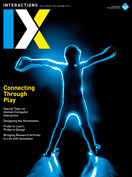Authors:
Ron Wakkary, Erik Stolterman
Investigating the future of digital play has become a central concern for HCI and interaction design researchers and practitioners. This interest is reflected in the creation of new conference venues like CHI PLAY (https://chiplay.acm.org). An interweaving of play within HCI research not only sheds light on aspects of games but also can be seen as contributing to a broader understanding of the social role and implications of design and technology. In this issue's cover story, Katherine Isbister demonstrates how design research of social games explores the potential of technological augmentations of our future social life. Isbister views games as a rich terrain for understanding everyday sociotechnological experiences, and as test beds for designing, understanding, and shaping near-future technology and social interactions. In playing games, we experiment with unconventional social roles, and, as Isbister suggests, with unconventional technology and technology use, which together open up new territories and spaces for HCI researchers.
Katherine Isbister demonstrates how design research of social games explores the potential of technological augmentations of our future social life.
Opening new territory for HCI research is naturally not unique to games research. While digital play is increasingly central to HCI research, the concerns of animal-technology interaction are emergent and exploratory in ways equally exciting, with the potential to be immeasurably impactful. In this issue, we present a special topic section on animal-computer interaction (ACI), edited by Steve North and Clara Mancini, that features several authors with different foci within the field. As North and Mancini explain, ACI is concerned with studying the relationship between animals and technology and how to best design interactive technology to support animals. ACI also investigates ways to consider animals as legitimate stakeholders in the design of technologies for them. However, as North and Mancini make clear, the key question is "if co-designing HCI artifacts is already fraught with misunderstanding, how might ACI researchers hope to design for and with other species?" New territory indeed!
As an avid Interactions reader you probably know that the magazine is online as well as in print. We encourage you to visit us at interactions.acm.org and take advantage of the unique perspectives of our bloggers in addition to articles from the latest issue.
And finally, don't limit yourself to just reading Interactions! We invite you to submit and share with us your ideas, work, research, demos, and photos for our Visual Thinking Gallery! Visit interactions.cm.org/submissions to see just how easy it is to be an Interactions author.
Ron Wakkary and Erik Stolterman
[email protected]
Copyright held by authors
The Digital Library is published by the Association for Computing Machinery. Copyright © 2016 ACM, Inc.








Post Comment
No Comments Found